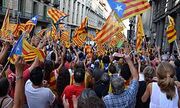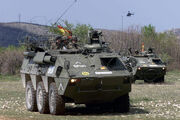|
This Scotland says "Yes" page is obsolete. |
| Date | 26th September 2014 - Ongoing | ||||||||||
| Location | Spain (Catalonia, Basque, Canaries, Valencia, Straits of Gibraltar) | ||||||||||
| Result | De Facto Catalonian Independence
Status Quo Conserved in Basque County UN Economic Sanctions against Spain De Facto Canarian Independence | ||||||||||
| |||||||||||
The Spanish Collapse Crisis, or Second Spanish Civil War, started during late 2014. While in Catalonia the conflict was mainly concluded with the act of separation on 1st January 2016, in the Canaries are de facto independent, and Basque has retained its status quo, it is seen by many to be likely to restart, and the current state is simply a hiatus.
Background[]
Catalonia is a distinctive region of Spain. Since the early 2000's it has had separatist movements. When, in September 2014, Scotland gained independence from the United Kingdom, independence sects started to call for independence, especially in Catalonia and the Basque.
History[]
March on Madrid[]
On the 26th September there was a mass protest in Barcelona after it was declared Scotland was to receive independence, with calls for the recent Catalan referendum to be taken seriously. With the Catalan Government being unable to do much more at that time, and the Central Spanish Government ignoring them, on the 27th a large proportion of the protestors marched for Madrid from Barcelona.

March on Madrid
Suffering heavy police and partisan harassment on the third day of the march, and with confrontation with Partisans, clashes resulted in the death of two. As they moved into the outskirts of Madrid a police blockade stopped them. After some hours attempting to push through the police lines to reach Madrid, violence began to break out with some brick throwing and, when Madrilenian partisans turned up and attacked, and events took a violent turn. The police controversially intervened with water cannons which knocked an elderly pensioner and a four year old child to the ground, hurting them both badly.
After the protesters roared and attacked police lines harder, the police had a major motorway (the E90) blocked for 24 hours as well as other annoyances. The police attacked the protesters camp hard with heavy riot gear. Amongst many other protesters and Catalan leaders, Arthur Mas was arrested and thrown in jail.
Uprising in Catalonia[]
When news broke of the injuries and arrests the people in Catalonia on October 9th, a general uprising began with public buildings being occupied. After an order from high police command was given to sort them out, a large proportion of the police in Barcelona defected, and, with their equipment, joined in the rioting. As Catalonia took this violent twist, the Spanish army was mobilized and sent out to crush the rebellion.

Variation of the Catalan Flag, flown by nationalists
On the 12th October the Spanish army encountered a military force attempting to hold a barricade at the Segre River and, in fighting between the two sides, two Spanish soldiers were injured while four civilians were killed and sixteen injured. The first Spanish soldier to die was killed by a Molotov cocktail when a convoy tried to retake Lledia and, although they moved through, they were unable to pacify it. The Spanish military continued to attempt to pacify towns throughout Catalonia as they advanced, but the rebels hid everywhere and just kept on once the military left; there was no further heavy fighting until they reach Barcelona on the 2nd November, where they encountered hard resistance.
The Battle for Barcelona[]

One of the two Moroccan Frigates passing through the Straits of Gibraltar
The night before, two Moroccan navy vessels by the names of Hassan II and Sultan Moulay Ismail escort a cargo freighter containing 250 assault rifles and five unguided anti-tank rockets along with ammunition. While all these weapons were much out of date they still worked and when the Spanish army entered Madrid when an armoured personnel carrier moving down a street was hit at point blank range by an anti-tank round which went through the armour.

Spanish APC's outside Barcelona
The vehicle was taken and later used in an attack where it pretended to be Spanish and then attacked and disabled another tank. Scenario's like this played out over the city with units actually armed and when a unit tried to retake the main government building they found themselves under attack by 30 armed men and were driven back. They later had to send a much larger force to recover the building. the battle for Barcelona lasted five days and shocked the world.
International Response[]

Spanish Troops on the Streets
As the Spanish government ordered a total lock down in Catalonia with soldiers out on the street and all rights suspended, Morocco tabled a UN resolution to launch economic sanctions on Spain on the 19th November. With scenes of soldiers on the streets while that resolution was rejected in favour of a lesser one banning Spain from importing anything expect basic supplies and also banned them from exporting until they offered a solution. The resolution was passed on the 22nd November.
Hearing these sanctions, riots sparked in the Basque Region and the Canary Islands. While the riots in Basque were put down more easily, rebel forces managed to secure many of the Canary Islands, and a Moroccan navy force blocked Spanish Naval Vessels from entering them. After a stand-off the Spanish naval force was forced to pull back due to a call from the government telling them to stand down.
With the Canary Islands de facto independent and troops now having to be sent into Basque as well as Catalonia and crippling sanctions the Spanish government was forced to negotiate with Catalonia or at least make a pretense. Yet the Catalonia separatists were aware that they had to keep the international support behind them and so with Spain's offer of near total autonomy on all except defense and foreign affairs they refused to talk unless Arthur Mas was released which the Spanish government refused.
Through heavy delaying tactics and as Spanish soldiers were still seen to be occupying Basque and Catalonia making them unpopular and on 17th January as public opinion in Europe was so against Spain Chancellor Merkel was forced to intercede and tell Spain either they resolved the issue or Spain would be removed from the EU and all of its bailout packages would be asked for return. This threat forced the Spanish government to finally bend knee and accept that Catalonia would break away but they believed Basque could still be saved.
De facto to de jure[]
While Catalonia was told it would receive independence in a new deal on the 16th February Basque was given more autonomy. The deal was refused by Basque and Catalonia made it clear that Basque had its rights.
On the 1st March Mariano Rajoy was deposed by a vote of no confidence after attempting controversial actions against the independence movements, and was replaced by his deputy, Soraya Sáenz de Santamaría. The new government shows more leniency towards both the Basque and Catalonia, though does not officially recognize them, and claims them as their own territory.
Other Events[]
Valencia[]
Valencia, a region of Spain to the South of Catalonia, and which shares much culture and a similar language, also experienced stirrings of rebellions with the conclusion of the March to Madrid, and continues to do so, though not to the extreme of Catalonia.
Gibraltar[]
Gibraltar is a British Overseas Territory bordering southern Spain, ceded to Britain in the Treaty of Utrecht in 1713. It had been a focal point in British-Spanish relations, in which Spain attempted to retake the territory and always ended up in failure. Gibraltarians highly oppose joint-sovereignty. Referendums taking place in 2002 and 2006 have shown it to be pro-British. As the crisis began, the Spanish requested that Britain shall not interfere with the unrest in Spain. Despite the protest, the UK government has shown vocal support to the Catalan demonstrations. In the Spain-Gibraltar border, security was tightened. Royal Gibraltar Police was deployed to the streets, the airport, and the nearby waters just in case of spillover of the conflict. The Royal Navy and the Royal Gibraltar Regiment of the British Army was also mobilized for the very same reason. On May 5, 2015, the American submarine USS Florida was harassed by a Spanish Guardia Civil vessel. The caused the Royal Navy patrol boat HMS Hermes too engage the Spanish vessel with flares, causing it to retreat back to Spanish territory. The captain of the Florida was about to engage the Spanish vessel should the Royal Navy escort have done nothing about it. This caused a series of diplomatic protests from the United Kingdom and the United States.
| ||||||||||||||||||||||||
| ||||||||||||||||||||


